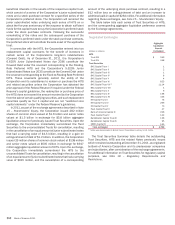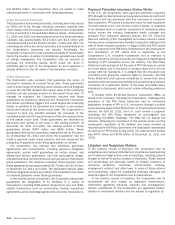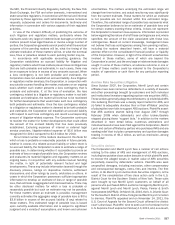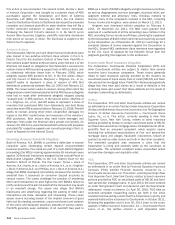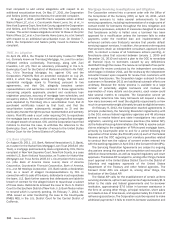Bank of America 2011 Annual Report Download - page 219
Download and view the complete annual report
Please find page 219 of the 2011 Bank of America annual report below. You can navigate through the pages in the report by either clicking on the pages listed below, or by using the keyword search tool below to find specific information within the annual report.Bank of America 2011 217
the SEC, the Financial Industry Regulatory Authority, the New York
Stock Exchange, the FSA and other domestic, international and
state securities regulators. In connection with formal and informal
inquiries by those agencies, such subsidiaries receive numerous
requests, subpoenas and orders for documents, testimony and
information in connection with various aspects of their regulated
activities.
In view of the inherent difficulty of predicting the outcome of
such litigation and regulatory matters, particularly where the
claimants seek very large or indeterminate damages or where the
matters present novel legal theories or involve a large number of
parties, the Corporation generally cannot predict what the eventual
outcome of the pending matters will be, what the timing of the
ultimate resolution of these matters will be, or what the eventual
loss, fines or penalties related to each pending matter may be.
In accordance with applicable accounting guidance, the
Corporation establishes an accrued liability for litigation and
regulatory matters when those matters present loss contingencies
that are both probable and estimable. In such cases, there may
be an exposure to loss in excess of any amounts accrued. When
a loss contingency is not both probable and estimable, the
Corporation does not establish an accrued liability. As a litigation
or regulatory matter develops, the Corporation, in conjunction with
any outside counsel handling the matter, evaluates on an ongoing
basis whether such matter presents a loss contingency that is
probable and estimable. If, at the time of evaluation, the loss
contingency related to a litigation or regulatory matter is not both
probable and estimable, the matter will continue to be monitored
for further developments that would make such loss contingency
both probable and estimable. Once the loss contingency related
to a litigation or regulatory matter is deemed to be both probable
and estimable, the Corporation will establish an accrued liability
with respect to such loss contingency and record a corresponding
amount of litigation-related expense. The Corporation continues
to monitor the matter for further developments that could affect
the amount of the accrued liability that has been previously
established. Excluding expenses of internal or external legal
service providers, litigation-related expense of $5.6 billion was
recognized for 2011 compared to $2.6 billion for 2010.
For a limited number of the matters disclosed in this Note for
which a loss is probable or reasonably possible in future periods,
whether in excess of a related accrued liability or where there is
no accrued liability, the Corporation is able to estimate a range of
possible loss. In determining whether it is possible to provide an
estimate of loss or range of possible loss, the Corporation reviews
and evaluates its material litigation and regulatory matters on an
ongoing basis, in conjunction with any outside counsel handling
the matter, in light of potentially relevant factual and legal
developments. These may include information learned through the
discovery process, rulings on dispositive motions, settlement
discussions, and other rulings by courts, arbitrators or others. In
cases in which the Corporation possesses sufficient appropriate
information to develop an estimate of loss or range of possible
loss, that estimate is aggregated and disclosed below. There may
be other disclosed matters for which a loss is probable or
reasonably possible but such an estimate may not be possible.
For those matters where an estimate is possible, management
currently estimates the aggregate range of possible loss is $0 to
$3.6 billion in excess of the accrued liability (if any) related to
those matters. This estimated range of possible loss is based
upon currently available information and is subject to significant
judgment and a variety of assumptions, and known and unknown
uncertainties. The matters underlying the estimated range will
change from time to time, and actual results may vary significantly
from the current estimate. Those matters for which an estimate
is not possible are not included within this estimated range.
Therefore, this estimated range of possible loss represents what
the Corporation believes to be an estimate of possible loss only
for certain matters meeting these criteria. It does not represent
the Corporation’s maximum loss exposure. Information is provided
below regarding the nature of all of these contingencies and, where
specified, the amount of the claim associated with these loss
contingencies. Based on current knowledge, management does
not believe that loss contingencies arising from pending matters,
including the matters described herein, will have a material
adverse effect on the consolidated financial position or liquidity
of the Corporation. However, in light of the inherent uncertainties
involved in these matters, some of which are beyond the
Corporation’s control, and the very large or indeterminate damages
sought in some of these matters, an adverse outcome in one or
more of these matters could be material to the Corporation’s
results of operations or cash flows for any particular reporting
period.
Auction Rate Securities Litigation
Since October 2007, the Corporation, Merrill Lynch and certain
affiliates have been named as defendants in a variety of lawsuits
and other proceedings brought by customers and both individual
and institutional investors regarding auction rate securities (ARS).
These actions generally allege that defendants: (i) misled plaintiffs
into believing that there was a deeply liquid market for ARS, and
(ii) failed to adequately disclose their or their affiliates’ practice
of placing their own bids to support ARS auctions. Plaintiffs assert
that ARS auctions started failing from August 2007 through
February 2008 when defendants and other broker/dealers
stopped placing those “support bids.” In addition to the matters
described in more detail below, numerous arbitrations and
individual lawsuits have been filed against the Corporation, Merrill
Lynch and certain affiliates by parties who purchased ARS and are
seeking relief that includes compensatory and punitive damages
totaling in excess of $1.2 billion, as well as rescission, among
other relief.
Securities Actions
The Corporation and Merrill Lynch face a number of civil actions
relating to the sales of ARS and management of ARS auctions,
including two putative class action lawsuits in which plaintiffs seek
to recover the alleged losses in market value of ARS securities
purportedly caused by defendants’ actions. Plaintiffs also seek
unspecified damages, including rescission, other compensatory
and consequential damages, costs, fees and interest. The first
action, In Re Merrill Lynch Auction Rate Securities Litigation, is the
result of the consolidation of two class action suits in the U.S.
District Court for the Southern District of New York. These suits
were brought by two Merrill Lynch customers on behalf of all
persons who purchased ARS in auctions managed by Merrill Lynch,
against Merrill Lynch and Merrill Lynch, Pierce, Fenner & Smith
Incorporated (MLPF&S). On March 31, 2010, the U.S. District Court
for the Southern District of New York granted Merrill Lynch’s motion
to dismiss. Plaintiffs appealed and on November 14, 2011, the
U.S. Court of Appeals for the Second Circuit affirmed the district
court’s dismissal. Plaintiffs’ time to seek a writ of certiorari to the
U.S. Supreme Court expired on February 13, 2012, and, as a result,







